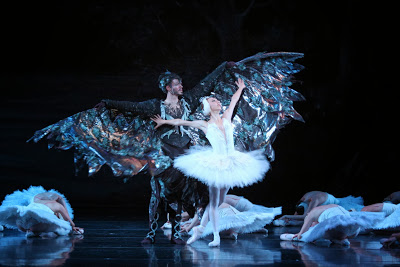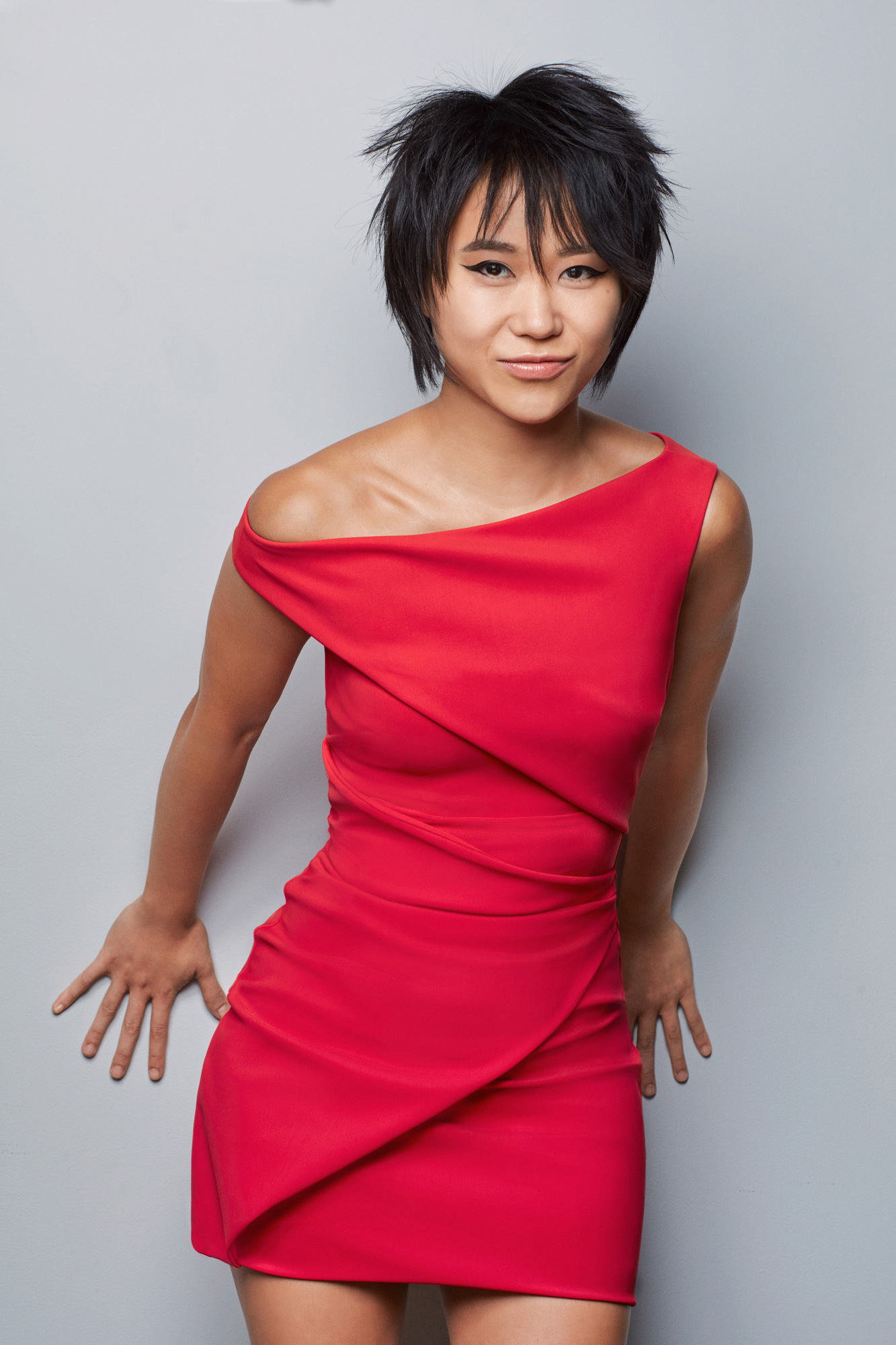| Jonathan Paul & Natalia Ashikhmina in Swan Lake. Photo by Wade Bell. |
Swan Lake
Choreography and staging by Bruce Simpson after Marius Petipa and Nicolas Beriosov
Music by Piotr Ilyich Tchaikovsky
A review by Kathi Ellis
Entire contents are copyright © 2013 Kathi Ellis. All rights reserved.
The Louisville Ballet kicked off their 2013-2014 season September 13-14 with Bruce Simpson’s elegant staging of the grand classic Swan Lake after choreography by Marius Petipa and Lev Ivanov. Mr. Simpson created this version when he was in Texas, and it was most recently produced in Louisville three years ago.
In the more than a century since the Petipa/Ivanov Swan Lake took to the stage, this ballet has become a significant touchstone in any company’s repertoire and is constantly being adapted and re-staged. Mr. Simpson’s version is a fine component of the Louisville Ballet’s repertoire.
With twenty-four artists in the company and fifteen trainees (plus community-based performers in some of the character roles), Mr. Simpson is able to populate the world of the ballet so that the Whitney Stage always looks replete. As at the beginning of any season, it is always good to see new dancers, adding to the depth and diversity of the company, as well as former trainees joining the ranks of the company and, of course, the many returning favorites.
Act One evokes a charming and idyllic occasion as the prince celebrates his twenty-first birthday with friends – in stark contrast to the prologue in which the evil spell of Rothbart (Mark Krieger, matinee) has overcome Princess Odette. The casting of Mr. Krieger, who is both a compelling dancer and an actor, in the role of Rothbart ensures that this character commands fear and attention in equal measure. Back in the sunny castle gardens, Siegfried’s friends capture the joie de vivre of youth celebrating the potential of the rest of their lives. A signature of this version is the naturalness of the responses of the characters watching the variations; Mr. Simpson’s program notes discuss making the story more relevant for today’s audiences, and this slight but significant loosening of balletic tradition, to allow for individual and authentic reactions, is one way this relevance is manifested.
Following the Soviet tradition, Mr. Simpson includes a jester as one of Siegfried’s confidants. On Saturday afternoon, Rob Morrow was a sparkling cynosure of the performance. Mr. Morrow clearly reveled in the airborne choreography for this role together with the opportunities to subvert court protocol, as well as “stepping back” when the focus needed to be on other parts of the story. He was a clear audience favorite. It was a pleasant surprise to see Cara Hicks, better known as an actress in the Louisville arts community, take the role of the Queen Mother, bringing a deliberative and authoritative presence to this character.
For this revival, the leading roles are shared by Natalia Ashikhmina and Erica De La O (Odette/Odile) and Mark Krieger and Kristofer Wotjera (Siegfried). At the Saturday matinee, the latter couple danced the roles. Mr.Wotjera always seems at home as the romantic lead, and this was especially the case at the matinee, after which he delivered an onstage proposal to Ms. De La O to the delight of the audience (and, yes, she did accept!). This post-performance event may have impacted his focus earlier in the afternoon, when his dancing was not as precise as usual. By the final act, Mr. Wotjera had regained his precision and elevation to support the passion of the story’s denouement. For my taste, Ms. De La O’s Odile was more satisfying than her Odette. Ms. De La O’s lissome arms are always an asset for her characterizations, but on Saturday afternoon she appeared much more attuned to the crisp, precise footwork in Odile’s Act Three appearance.
Act Three, of course, is the grand spectacle with all the potential princesses for Siegfried’s hand presenting them and with entertainment provided by dances from several different countries. The handsome set by Peter Farmer (courtesy Royal Winnipeg Ballet) creates the oppressive, formal environment under which Siegfried chafes. The six princesses were appropriately elegant and eligible, their disappointment and shock as Siegfried unconditionally rejects them all gaining sympathy from the audience. The four divertissements – Spanish, Neapolitan, Russian and Hungarian – provided excellent entertainment, with each variation visually and musically reflecting each culture and, at times, it felt like Mr. Simpson was paying homage to other contemporary choreographers, with echoes of iconic steps and body shapes. The costumes (costume design also by Mr. Farmer) of the Russian and Hungarian variations were sufficiently out of the color palette of the court that the blue tones popped out from the gathered courtiers, overwhelming the delicate coloring of the Neapolitan couple, pulling focus even during the other variations.
The swans of Acts Two and Four are the spine of the ballet, and the corps of eighteen swans smoothly and elegiacally filled the stage, dancing with unity and unison, trainees and full company members blending into a seamless whole. The opening of Act Four was particularly evocative as the swans rose from the mists billowing across the lake as they awaited Odile. Mr. Simpson’s use of the arms to create the illusion of swans is particularly effective: with one arm extended above the neck the swan comes into being; with two arms the wings become palpable; and both attitudes are fluidly interchanged throughout both acts. The delightful pas de quatre of the cygnets demonstrated well-executed footwork, but the head movements were not as exactly articulated.
The program offers specific thanks for audio consultation for this production. The recorded music was exceptionally crisp and clear, filling the Whitney in a way usually associated with a live orchestra.
Mr. Simpson has programmed both Swan Lakeand La Sylphide into this season, a marked shift from the less traditional full-length ballets produced during the past few seasons. I have mixed feelings about this. I will always enjoy a well-executed traditional ballet, but I also enjoy being introduced to newer pieces and truly enjoy seeing this versatile company embrace diverse styles within the full-length ballet format. This season we will see works by Ma Cong, Hougland and Caniparoli on one night in short pieces, but no significant contemporary full-length piece, such as The Three Musketeers or The Lady of the Camellias of recent seasons. I hope that future seasons will restore this balance. In the meantime, having experienced this season’s swans in this production, I’m already anticipating the sylphs to which we’ll be introduced next February. (Attendees at Studio Connections will have seen part of Act Two of La Sylphide last fall, a wonderful teaser for the full experience this season.)
Swan Lake
September 13 & 14, 2013
Louisville Ballet
Kentucky Center
501 West Main Street
Louisville, KY, 40202
502-589-7777





